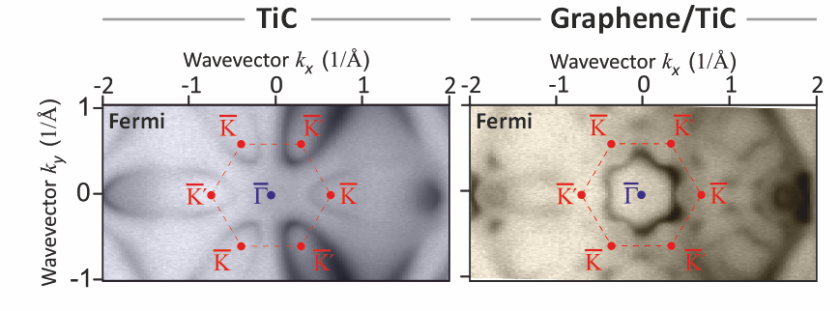Graphene on titanium carbide triggers a novel phase transition

Graphene-induced Lifshitz-transition from a petal-shaped Fermi surface to a gear-shaped hole Fermi surface revealed by comparative full photoemission mapping of the band structures of bare TiC(111) and graphene/TiC(111). © HZB
Researchers have discovered a Lifshitz-transition in TiC, driven by a graphene overlayer, at the photon source BESSY II. Their study sheds light on the exciting potential of 2D materials such as graphene and the effects they can have on neighboring materials through proximity interactions.
Stacking 2D materials has garnered a lot of attention in recent years as it provides a unique opportunity to tailor material properties in a highly controllable manner. However, the influence of 2D materials on the properties of neighboring materials through proximity effects is not yet fully understood. In particular, very sensitive properties such as band gaps in semiconductors and excitonic properties have been observed to be influenced. Fermi surfaces of bulk metals have so far not been among the properties sensitive to a proximity effect.
The Fermi surface of a metal is a mathematical concept to represent the electrons of the highest energy in the material. Only these electrons participate in properties such as electrical conductivity. An important aspect of the Fermi surface is that it represents them in terms of the direction of their movement.
The new study by Andrei Varykhalov and his colleagues at BESSY II shows that a graphene layer can induce a Lifshitz transition in the near-surface region of an underlying metal, TiC: The Fermi surface transforms from a hole-like to an electron-like Fermi surface. The reported change in Fermi surface character is particularly relevant since it changes the orientation of the movement of the electrons and in the presence of a magnetic field it changes the orientation of the macroscopic electric current.
The present finding is an exciting development as it provides a new avenue for controlling and manipulating the electronic properties of materials, which has implications for a range of technological applications, for example designing materials with quantum properties such as high temperature superconductivity.
red.
https://www.helmholtz-berlin.de/pubbin/news_seite?nid=24892;sprache=en
- Copy link
-
Battery research with the HZB X-ray microscope
New cathode materials are being developed to further increase the capacity of lithium batteries. Multilayer lithium-rich transition metal oxides (LRTMOs) offer particularly high energy density. However, their capacity decreases with each charging cycle due to structural and chemical changes. Using X-ray methods at BESSY II, teams from several Chinese research institutions have now investigated these changes for the first time with highest precision: at the unique X-ray microscope, they were able to observe morphological and structural developments on the nanometre scale and also clarify chemical changes.
-
BESSY II: New procedure for better thermoplastics
Bio-based thermoplastics are produced from renewable organic materials and can be recycled after use. Their resilience can be improved by blending bio-based thermoplastics with other thermoplastics. However, the interface between the materials in these blends sometimes requires enhancement to achieve optimal properties. A team from the Eindhoven University of Technology in the Netherlands has now investigated at BESSY II how a new process enables thermoplastic blends with a high interfacial strength to be made from two base materials: Images taken at the new nano station of the IRIS beamline showed that nanocrystalline layers form during the process, which increase material performance.
-
Hydrogen: Breakthrough in alkaline membrane electrolysers
A team from the Technical University of Berlin, HZB, IMTEK (University of Freiburg) and Siemens Energy has developed a highly efficient alkaline membrane electrolyser that approaches the performance of established PEM electrolysers. What makes this achievement remarkable is the use of inexpensive nickel compounds for the anode catalyst, replacing costly and rare iridium. At BESSY II, the team was able to elucidate the catalytic processes in detail using operando measurements, and a theory team (USA, Singapore) provided a consistent molecular description. In Freiburg, prototype cells were built using a new coating process and tested in operation. The results have been published in the prestigious journal Nature Catalysis.
